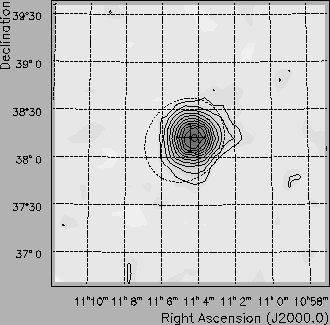 |
Active galactic nuclei (AGN) are galaxies with an unresolved central nucleus that outshines the rest of the galaxy and for which the emission is often dominated by nonthermal processes. Their emission is widely believed to be powered by accretion onto a supermassive black hole. The only AGN detected at gamma-ray energies are blazars: radio-loud, flat spectrum sources characterized by highly variable and primarily non-thermal emission at most wavelengths. Flat spectrum radio quasars and BL Lacertae objects (BL Lacs) are members of the blazar class of AGN. The rapid variability and radio properties of these objects imply that they have relativistic jets whose axes make small angles with respect to the observer's line of sight. The gamma-ray emission from these objects is also most naturally explained as beamed radiation from the jets which is Doppler boosted in energy and luminosity. Currently, no model for the production of gamma-rays in the AGN is generally accepted. The two most popular classes are those in which high energy electrons (known to be present in the jets from radio, optical, and X-ray observations) produce the gamma-rays by inverse Compton scattering of low energy photons and those in which very high energy protons produce the gamma-rays by initiating cascades within the jets. These two processes are illustrated schematically in Figure 2.
 |
Whipple observations of Markarian 421
(Mrk 421; Figure 3) and Mrk 501 have revealed
extremely variable VHE emission (Figure 4;
[Quinn et al. 1999]; [Gaidos et al. 1996]). Variability on a 15 minute time-scale
observed in Mrk 421 ([Gaidos et al. 1996]) implies a compact emission
region of dimension
![]() parsec (pc) which is only an
order of magnitude larger than the radius of the event horizon of a
108 solar mass black hole. The emission region might exist at a
somewhat greater distance from the central object (e.g., at a shock
front propagating out along the jet), but this emission still
originates well inside the
parsec (pc) which is only an
order of magnitude larger than the radius of the event horizon of a
108 solar mass black hole. The emission region might exist at a
somewhat greater distance from the central object (e.g., at a shock
front propagating out along the jet), but this emission still
originates well inside the ![]() 1pc region directly imaged by
current radio telescopes. Correlations observed between X-rays and
VHE gamma-rays (e.g., Figure 4; [Macomb et al. 1995];
[Buckley et al. 1996]; [Catanese et al. 1997]) are most easily explained as
emission at both wavelengths being produced by the same population of
electrons. However, models which produce gamma-rays primarily
through proton interactions ([Mannheim 1993]) can also explain the
observations. The combined low energy and VHE data provide
quantitative constraints on jet parameters such as the magnetic field
strength and Doppler factor. Whipple and EGRET observations have also
led to reformulations of blazar unification models based on intrinsic
source luminosity rather than solely on the effects of orientation
differences ([Ghisellini et al. 1998]; [Georganopoulos & Marscher 1998]).
1pc region directly imaged by
current radio telescopes. Correlations observed between X-rays and
VHE gamma-rays (e.g., Figure 4; [Macomb et al. 1995];
[Buckley et al. 1996]; [Catanese et al. 1997]) are most easily explained as
emission at both wavelengths being produced by the same population of
electrons. However, models which produce gamma-rays primarily
through proton interactions ([Mannheim 1993]) can also explain the
observations. The combined low energy and VHE data provide
quantitative constraints on jet parameters such as the magnetic field
strength and Doppler factor. Whipple and EGRET observations have also
led to reformulations of blazar unification models based on intrinsic
source luminosity rather than solely on the effects of orientation
differences ([Ghisellini et al. 1998]; [Georganopoulos & Marscher 1998]).
 |
Despite these gains, we have much to learn about these enigmatic objects. VERITAS can help answer many of the unknowns concerning blazars, particularly when combined with lower energy observations by GLAST, X-ray and optical telescopes. We will approach the study of AGN from two perspectives: detailed studies where we conduct long observations of individual objects to reveal the physics operating in the AGN, and broad studies where we detect more VHE sources to illuminate patterns among various objects.
 |